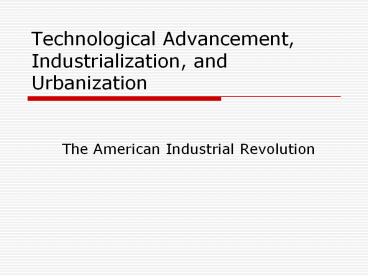Technological Advancement, Industrialization, and Urbanization PowerPoint PPT Presentation
1 / 10
Title: Technological Advancement, Industrialization, and Urbanization
1
Technological Advancement, Industrialization, and
Urbanization
- The American Industrial Revolution
2
The Industrial Revolution
- Generally speaking, the Industrial Revolution
refers to the period in the late 18th and early
19th centuries when changes in manufacturing,
transportation, and agriculture had a profound
effect on the socioeconomic and cultural
conditions in Britain. - These changes subsequently spread throughout
Europe and North America (and later the world)
through a process known as industrialization.
3
Technology
- Technological innovation was at the heart of the
Industrial Revolution, and the key technological
advancement was the invention and improvement of
the steam engine. - The first practical steam-powered 'engine' was a
water pump, developed in 1698 by Thomas Savery.
It proved only to have a limited lift height and
was prone to boiler explosions, but it still
received some use for mines and pumping stations. - The first commercially-successful engine did not
appear until 1712. Incorporating technologies
discovered by Savery and Denis Papin, the
atmospheric engine, invented by Thomas Newcomen,
paved the way for the Industrial Revolution.
4
The Steam Engine
5
Protestant Work Ethic
- Some scholars believe that the British industrial
advance was due in part to the presence of a
entrepreneurial class which believed in progress,
technology, and hard work. - The existence of this class is often linked to
the Protestant work ethic (see Max Weber) and the
particular status of the dissenting Protestant
sects. - Reinforcement of confidence in the rule of law,
which followed the period of the Glorious
Revolution, and the emergence of a stable
financial market in Great Britain were also
believed to contribute.
6
Impacts - General
- The onset of the Industrial Revolution marked a
major turning point in human society almost
every aspect of daily life was eventually
influenced in some way. - In the later part of the 1700s the manual
labor-based economy of some parts of Great
Britain began to be replaced by one dominated by
manufacture by machinery. - The introduction of steam power (fuelled
primarily by coal) and powered machinery (mainly
in textile manufacturing) underpinned the
dramatic increases in production capacity. The
development of all-metal machine tools in the
first two decades of the 19th century facilitated
the manufacture of more production machines for
manufacturing in other industries. The effects
spread throughout Western Europe and North
America during the 19th century, eventually
affecting most of the world. The impact of this
change on society was enormous.
7
Impacts The Factory
- Industrialization led to the creation of the
factory. - The factory system was largely responsible for
the rise of the modern city, as large numbers of
workers migrated into the cities in search of
employment in the factories.
8
Impacts The City
- The growth of modern industry from the late 18th
century onward led to massive urbanization and
the rise of new great cities, first in Europe and
then in other regions, as new opportunities
brought huge numbers of migrants from rural
communities into urban areas. In the United
States from 1860 to 1910, the invention of
railroads reduced transportation costs, and large
manufacturing centers began to emerge, thus
allowing migration from rural to city areas.
However, cities during those periods of time were
deadly places to live in, due to health problems
resulting from contaminated water and air, and
communicable diseases.
9
Impacts Labor Practice
- The Industrial Revolution led to a population
increase, but the chance of surviving childhood
did not improve throughout the industrial
revolution (although infant mortality rates were
improved markedly). - There was still limited opportunity for
education, and children were expected to work.
Employers could pay a child less than an adult
even though their productivity was comparable
there was no need for strength to operate an
industrial machine, and since the industrial
system was completely new there were no
experienced adult laborers. - This made child labor the labor of choice for
manufacturing in the early phases of the
Industrial Revolution between the 18th and 19th
centuries.
10
Political Theory and Industrialization
- Marxism can be understood in part as a reaction
to the Industrial Revolution. According to Karl
Marx, industrialization polarized society into
the bourgeoisie (those who own the means of
productionthe factories and the land) and the
proletariat (the working class who actually
perform the labor necessary to extract something
valuable from the means or production. - Romanticism, which we began discussing yesterday,
can also be understood partially through its
relation to industrialization. As you might
imagine, this artistic and philisophical movement
was hostile towards the new industrialization.
The movement stressed the importance of nature
in art and language, in contrast to the
monstrous machines and factories, the dark
satanic mills of Blakes poem.

